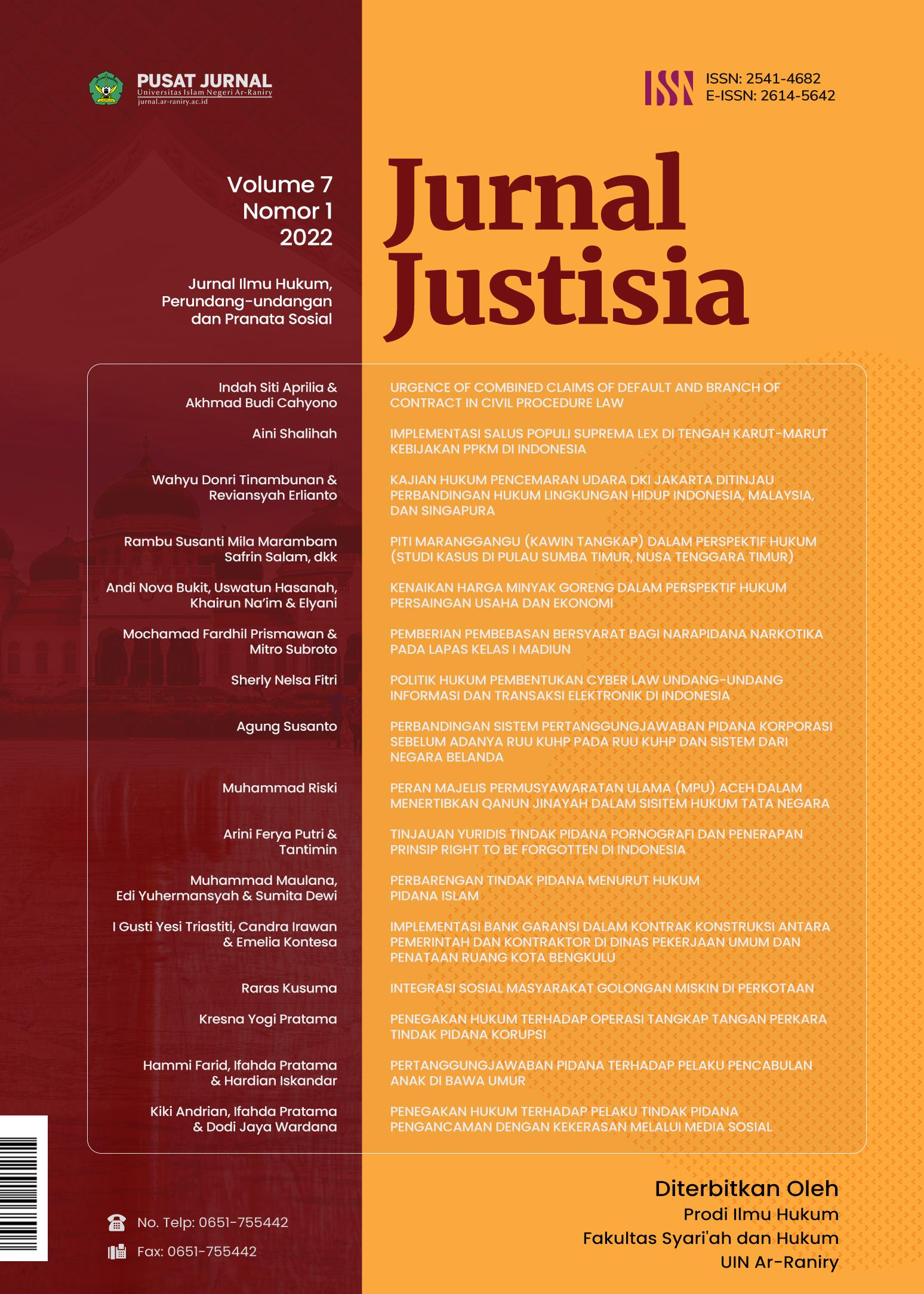Penegakan Hukum Terhadap Pelaku Tindak Pidana Pengancaman Dengan Kekerasan Melalui Media Sosial
DOI:
https://doi.org/10.22373/justisia.v7i1.13220Abstract
The mechanism in this world is accelerating, one of which is entertainment based on social media sites, here and there people get influence to cause offense problems. Virtual entertainment is a medium on the website that allows clients to talk to themselves and cooperate, collaborate, share, and talk to different clients. The law controls communication between people with the aim of preventing it from happening. What is meant by problem is the way of law enforcement against demonstrations or criminal hazards as indicated by the Criminal Code, and the second is the way to enforce the Threats Act by force in accordance with the Electronic Information Transactions Act. The exploration strategy used in this test is standardization which plans to find answers to the issues that arise in it. These checks are also subject to regulations in the guidelines and are appointed by the manufacturer. By regulation, the danger of brutality is addressed in Article 335 Paragraph (1) of the Criminal Code. The Law on Information and Electronic Transactions regulates various legal guarantees for activities that use the web as a medium, exchange and use of data. In Article 29 of Law Number 11 of 2008 concerning Threats Through Information Media and Electronic Transactions, these articles are interrelated. 19 of 2016 concerning Amendments to Law Number 11 of 2008 concerning Information and Electronic Transactions. Danger is a type of action that does not directly threaten or frighten someone so that it causes stress, and is awkward. savagery is that which worries something, is branded harshly.
References
Anjari, W. (2014). Fenomena Kekerasan sebagai Bentuk Kejahatan (Violence). E-Journal WIDYA Yustisia, 1(1), 42–51. Retrieved from https://media.neliti.com/media/publications/246968-fenomena-kekerasan-sebagai-bentuk-kejaha-60c284aa.pdf
D Sulolipu, A. I. (2019). Analisis Tindak Pidana Pengancaman Melalui Pesan Singkat. Al-Ishlah : Jurnal Ilmiah Hukum, 22(1), 45–52. https://doi.org/10.33096/aijih.v22i1.26
Furqon, A. (2018). Yuridis Terhadap Tindak Pidana Pengancaman Yang Dilakukan Secara Bersama-Sama. Jurnal Hukum Volkgeist, 2(2), 119–134. https://doi.org/10.35326/volkgeist.v2i2.107
Habibi, D. R. (2019). Penegakan Hukum Terhadap Pelaku Tindak Pidana Pengancaman Kekerasa dan Pembunuhan Melalui Media Sosial (Studi di Resor Kriminal Polrestabes Medan). Retrieved from http://repository.umsu.ac.id/bitstream/123456789/6174/1/SKRIPSI DONI RAHMAD HABIBI.pdf
KASUISTIKA. (2017). Jimly Asshiddiqie: Penegakan Hukum Kunci Berdemokrasi. Retrieved April 23, 2022, from jawapos.com website: https://www.jawapos.com/nasional/hukum-kriminal/25/02/2017/jimly-asshiddiqie-penegakan-hukum-kunci-berdemokrasi/
Kou, B. Y. (2017). Pendaftaran Tanah Secara Sistematis Terhadap Tanah Bekas Hak Adat di Kecamatan Cibal Kabupaten Manggarai Setelah Berlakunya PP 24 Tahun 1997 Tentang Pendaftaran Tanah. Thesis, 13(April), 15–38.
Setiadi, A. (2014). Pemanfaatan media sosial untuk efektifitas komunikasi. Jurnal Ilmiah Matrik, 16(1).
Undang, U., & Purnama, A. (2018). Kajian mengenai Undang Undang tentang Informasi dan Transaksi Elektronik. (April), 1.
Downloads
Additional Files
Published
Issue
Section
License
The Authors submitting a manuscript do so on the understanding that if accepted for publication, copyright of the article shall be assigned to Jurnal Justisia : Jurnal Ilmu Hukum, Perundang-undangan dan Pranata Sosial, Ar-Raniry State Islamic University, Indonesia as the publisher of the journal.
Jurnal Justisia : Jurnal Ilmu Hukum, Perundang-undangan dan Pranata Sosial right of first publication with the work simultaneously licensed under Creative Commons Attribution-ShareAlike 4.0 International License (CC BY-SA 4.0) that allows others to share (copy and redistribute the material in any medium or format) and adapt (remix, transform, and build upon the material) the work for any purpose, even commercially with an acknowledgment of the work's authorship and initial publication in Jurnal Justisia : Jurnal Ilmu Hukum, Perundang-undangan dan Pranata Sosial. Authors are able to enter into separate, additional contractual arrangements for the non-exclusive distribution of the journal's published version of the work (e.g., post it to an institutional repository or publish it in a book), with an acknowledgment of its initial publication in Jurnal Justisia : Jurnal Ilmu Hukum, Perundang-undangan dan Pranata Sosial. Authors are permitted and encouraged to post their work online (e.g., in institutional repositories or on their website) prior to and during the submission process, as it can lead to productive exchanges, as well as earlier and greater citation of published work (See The Effect of Open Access).

